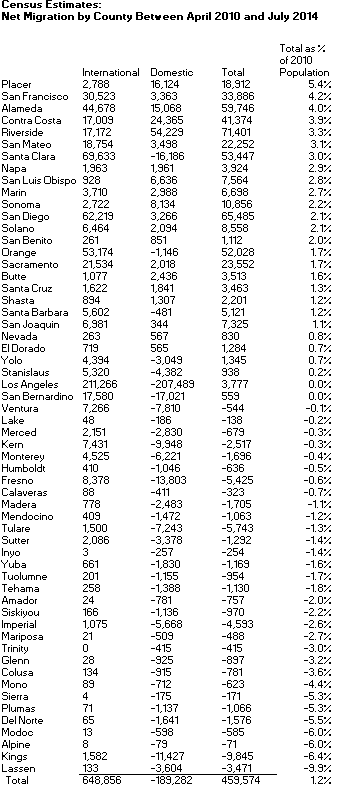New Federal County and Metro Population Estimates. The Census Bureau has released new county and metropolitan area population estimates that cover the period through 2014. Key tables showing the bureau's estimates of California population changes are on the Census website, including tables showing annual county population changes since 2010 and the components of population changes (births, deaths, and migration).
Florida and Texas Population Growth. Among all metropolitan areas, the Census Bureau highlights that the 20 fastest-growing since 2013 were largely in Florida and Texas. (The same general trend was true of large metropolitan areas, according to an analysis of the data by Trulia.) Another Trulia analysis discussed today in The New York Times showed that 2014 population growth was concentrated in metropolitan areas where winters were relatively warm, "continuing a long-term trend." A table in The New York Times article highlights that recent population growth in California's Inland Empire and Las Vegas, Nevada, among other places, has been far slower than it was between 1980 and 2000.
A Spotlight on Migration To and From California. There are many interesting elements to the population growth data. One set of data to highlight shows domestic and international net migration to California since the 2010 Census. Since 2010, California's population is estimated by the Census Bureau to have grown by 1.2% (459,574 people) due to migration, specifically gains in international migration. When "natural" population increases (births less deaths here) are included, the state's overall population is estimated to have grown by a total of 4.2% since 2010 (1.5 million people, including a natural increase of 1.1 million plus the 459,574 increase from migration noted above).
Relatively few metropolitan areas are reported to have notable recent gains from both domestic and international migration. San Francisco is among those areas. (Trulia maps on the Twitter feed of economist Jed Kolko show county population changes due to net international and domestic migration in 2014.) As shown below, however, between 2010 and 2014, the county in California with the largest percentage growth in population from migration is Placer County, which is northeast of Sacramento. Placer's in-migration results overwhelmingly from domestic migration (that is, from other counties in the United States), while international migration is much more important for several Bay Area counties. Riverside County also ranks high on this list due primarily to domestic migration. San Diego and Orange County experienced international migration gains since 2010, the Census reported. Net migration totals for Los Angeles, San Bernardino, and Ventura Counties since 2000 have been minor, with international gains offset by domestic migration losses. The counties with the greatest percentages of their population migrating away since 2000 have generally been in the North State.
More Background from PPIC and Other Sources. The Public Policy Institute of California (PPIC) notes that before 1990, "most of California's population growth was due to migration, primarily from the rest of the United States." Since 1990, however, most growth has been due to natural increase. "Over the past 10 years," PPIC reports, "gains through international migration have been offset by domestic migration losses." "In the past 10 years," PPIC adds, "immigration from Latin America has slowed while immigration from Asia has increased," with the majority of recent immigrants coming from Asia. PPIC also has reported that most international immigrants to California are working-age adults, with a significant portion not having completed high school, while recent immigrants and immigrants from Asia have tended to have "very high levels of educational attainment." Immigrants are more likely than U.S.-born residents to be employed, but make less money, PPIC calculated in 2013. Overall, around one-fourth of Californians are foreign born, a "higher proportion than in any other state," according to PPIC.
In our recent report, California's High Housing Costs: Causes and Consequences (see page 33 of the pdf version), we noted that the ratio of in-migration to out-migration, a measure of population flow, is lowest when California's home prices are high relative to other places. High housing costs, we added, discourage people from living in California.

